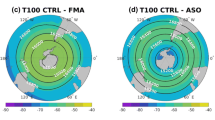Abstract
Although ozone appears in the Earth’s atmosphere in a small abundance, it plays a key role in the energy balance of the planet through its involvement in radiative processes. Its absorption of solar radiation leads to the temperature increase with height defining the tropopause and the stratosphere. Moreover, excluding water vapor, O3 is the third most important contributor (after CO2 and CH4) to the greenhouse radiative forcing. Thus, the total removal of O3 content in an Earth-like atmosphere may cause interesting response of the climate system that deserves further investigation. The present paper addresses this issue by means of a global climate model where the atmosphere is coupled with a passive ocean of a given depth. The model, after reaching the statistical equilibrium under present climate conditions, is perturbed by a sudden switch off of the O3 content. Results obtained for the new equilibrium suggest that the model gets in a colder state mainly because of the water vapor content decrease. Most of the cooling occurs in the Southern Hemisphere while in the Northern Hemisphere the ice cap melts quite consistently. This process appears to be governed by the northward cross-equatorial heat transports induced by changes in the general circulation.






Similar content being viewed by others
References
Bordi I, Dell'Aquila A, Speranza A, Sutera A (2004) On the midlatitude tropopause height and the orographic-baroclinic adjustment theory. Tellus 56A:278–286
Bordi I, Fraedrich K, Lunkeit F, Sutera A (2007) Tropospheric double-jets, meridional cells and eddies: a case study and idealized simulations. Mon Weather Rev 135:3118–3133
Christy JR, Norris WB, Spencer RW, Hnilo JJ (2007) Tropospheric temperature change since 1979 from tropical radiosonde and satellite measurements. J Geophys Res 112:D06102. doi:10.1029/2005JD006881
Fraedrich K, Jansen H, Kirk E, Luksch U, Lunkeit F (2005) The planet simulator: towards a user friendly model. Meteorol Zeitschrift 14:299–304
Green AES (1964) Attenuation by ozone and the earth’s albedo in the middle ultraviolet. J Appl Opt 3:203–208
IPCC (2007) Climate change 2007—the physical science basis. In: Solomon S, Qin D, Manning M, Chen Z, Marquis M, Averyt KB, Tignor M, Miller HL (eds) Contribution of working group I to the fourth assessment report of the intergovernmental panel on climate change. Cambridge University Press, Cambridge, p 996
Lacis AA, Hansen JE (1974) A parameterization for the absorption of solar radiation in the Earth’s atmosphere. J Atmos Sci 31:118–133
Lee W-H, North GR (1995) Small ice cap instability in the presence of fluctuations. Clim Dynam 11:242–246
Lindzen RS (1990) Dynamics in atmospheric physics. Cambrige University Press, p 310
Ramanathan V, Dickinson RE (1979) The role of stratospheric ozone in the zonal and seasonal radiative energy balance of the earth-troposphere system. J Atmos Sci 36:1084–1104
Saltzman B, Sutera A (1984) A model of the internal feedback system involved in late quaternary climatic variations. J Atmos Sci 41:736–745
Sasamori T (1968) The radiative cooling calculation for application to general circulation experiments. J Appl Meteor 7:721–729
Stephens GL (1978) Radiation profiles in extended water clouds. II: parameterization schemes. J Atmos Sci 35:2123–2132
Stephens GL, Ackermann S, Smith EA (1984) A shortwave parameterization revised to improve cloud absorption. J Atmos Sci 41:687–690
WMO (2011) Scientific assessment of ozone depletion: 2010, Global Ozone Research and Monitoring Project—Report No. 52, Geneva, Switzerland, p. 516
Acknowledgments
The ozone data displayed in Fig. 6 have been freely retrieved from the World Ozone and Ultraviolet Radiation Data Centre (WOUDC) from their web site http://www.woudc.org/data/summaries_e.html. Stratospheric temperature anomaly data shown in Fig. 6 have been retrieved from the National Space Science and Technology Center from their web site http://vortex.nsstc.uah.edu. Support by the Max Planck Society is acknowledged (KF).
Author information
Authors and Affiliations
Corresponding author
Rights and permissions
About this article
Cite this article
Bordi, I., Fraedrich, K., Sutera, A. et al. On the climate response to zero ozone. Theor Appl Climatol 109, 253–259 (2012). https://doi.org/10.1007/s00704-011-0579-5
Received:
Accepted:
Published:
Issue Date:
DOI: https://doi.org/10.1007/s00704-011-0579-5



